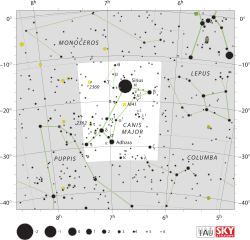Sigma Canis Majoris

| |
| Observation data Epoch J2000 Equinox J2000 | |
|---|---|
| Constellation | Canis Major |
| Right ascension | 07h 01m 43.14779s[1] |
| Declination | –27° 56′ 05.3898″[1] |
| Apparent magnitude (V) | +3.41[2] |
| Characteristics | |
| Spectral type | M1.5 Iab[3] |
| U−B color index | +1.75[2] |
| B−V color index | +1.69[2] |
| Astrometry | |
| Radial velocity (Rv) | +22.11[4] km/s |
| Proper motion (μ) | RA: –5.98[1] mas/yr Dec.: +4.59[1] mas/yr |
| Parallax (π) | 2.91 ± 0.19[1] mas |
| Distance | 1,120 ± 70 ly (340 ± 20 pc) |
| Absolute magnitude (MV) | –5.14[5] |
| Details | |
| Mass | 12.3 ± 0.1[6] M☉ |
| Radius | 420[5] R☉ |
| Luminosity | 32,000[7] L☉ |
| Surface gravity (log g) | 1.00[8] cgs |
| Temperature | 3,877[8] K |
| Metallicity [Fe/H] | +0.16[8] dex |
| Age | 16.4 ± 0.5[6] Myr |
| Other designations | |
Sigma Canis Majoris (σ CMa, σ Canis Majoris) is a star in the southern constellation of Canis Major. It is approximately 1,120 light-years (340 parsecs) from Earth[1] and has an average apparent visual magnitude of +3.41.[2]
σ CMa is a supergiant star with a stellar classification of M1.5 Iab.[3] This is a type of star that is in the late stages of its evolution, having consumed the hydrogen at its core and ballooned out to 420 times the Sun's radius.[5] At 1.95 Astronomical Units,[11] this is radius nearly double the average distance of the Earth from the Sun. It is currently radiating about 32,000[7] times the luminosity of the Sun from its outer envelope at an effective temperature of around 3,877 K.[8] This gives it the cool orange-red hue of an M-type star.[12]
It is classified as an irregular variable star and its brightness varies from magnitude +3.43 to +3.51. The magnetic field of this star has a strength below 1 G.[3] It is suspected of being a member of the Collider 121 stellar association of co-moving stars,[5] but this is disputed.[13]
Culture signification
The indigenous Boorong people of northwestern Victoria saw it as Unurgunite, flanked by his wives (Epsilon and Delta Canis Majoris).[10]
References
- ↑ 1.0 1.1 1.2 1.3 1.4 1.5 van Leeuwen, Floor (November 2007), "Validation of the new Hipparcos reduction", Astronomy and Astrophysics 474 (2): 653–664, arXiv:0708.1752v1, Bibcode:2007A&A...474..653V, doi:10.1051/0004-6361:20078357 Note: see VizieR catalogue I/311.
- ↑ 2.0 2.1 2.2 2.3 Fernie, J. D. (May 1983), "New UBVRI photometry for 900 supergiants", Astrophysical Journal Supplement Series 52: 7–22, Bibcode:1983ApJS...52....7F, doi:10.1086/190856
- ↑ 3.0 3.1 3.2 Grunhut, J. H. et al. (November 2010), "Systematic detection of magnetic fields in massive, late-type supergiants", Monthly Notices of the Royal Astronomical Society 408 (4): 2290–2297, arXiv:1006.5891, Bibcode:2010MNRAS.408.2290G, doi:10.1111/j.1365-2966.2010.17275.x
- ↑ Mermilliod, J. C.; Mayor, M.; Udry, S. (July 2008), "Red giants in open clusters. XIV. Mean radial velocities for 1309 stars and 166 open clusters", Astronomy and Astrophysics 485 (1): 303–314, Bibcode:2008A&A...485..303M, doi:10.1051/0004-6361:200809664
- ↑ 5.0 5.1 5.2 5.3 Levesque, Emily M. et al. (August 2005), "The Effective Temperature Scale of Galactic Red Supergiants: Cool, but Not As Cool As We Thought", The Astrophysical Journal 628 (2): 973–985, arXiv:astro-ph/0504337, Bibcode:2005ApJ...628..973L, doi:10.1086/430901
- ↑ 6.0 6.1 Tetzlaff, N.; Neuhäuser, R.; Hohle, M. M. (January 2011), "A catalogue of young runaway Hipparcos stars within 3 kpc from the Sun", Monthly Notices of the Royal Astronomical Society 410 (1): 190–200, arXiv:1007.4883, Bibcode:2011MNRAS.410..190T, doi:10.1111/j.1365-2966.2010.17434.x
- ↑ 7.0 7.1 Mallik, Sushma V. (December 1999), "Lithium abundance and mass", Astronomy and Astrophysics 352: 495–507, Bibcode:1999A&A...352..495M
- ↑ 8.0 8.1 8.2 8.3 Mallik, Sushma V. (October 1998), "Chromospheric activity in cool stars and the lithium abundance", Astronomy and Astrophysics 338: 623–636, Bibcode:1998A&A...338..623M
- ↑ "sig CMa -- Pulsating variable Star", SIMBAD (Centre de Données astronomiques de Strasbourg)
- ↑ 10.0 10.1 Hamacher, Duane W.; Frew, David J. (2010). "An Aboriginal Australian Record of the Great Eruption of Eta Carinae" (PDF). Journal of Astronomical History & Heritage 13 (3): 220–34.
- ↑ 1 solar radius = 0.0046491 Astronomical Units, so 420 × 0.00465 = 1.95.
- ↑ "The Colour of Stars", Australia Telescope, Outreach and Education (Commonwealth Scientific and Industrial Research Organisation), December 21, 2004, retrieved 2012-01-16
- ↑ de Zeeuw, P. T. et al. (January 1999), "A HIPPARCOS Census of the Nearby OB Associations", The Astronomical Journal 117 (1): 354–399, arXiv:astro-ph/9809227, Bibcode:1999AJ....117..354D, doi:10.1086/300682
| ||||||||||||||||||||||||||||||||||||||||||||||||||||||||||||||